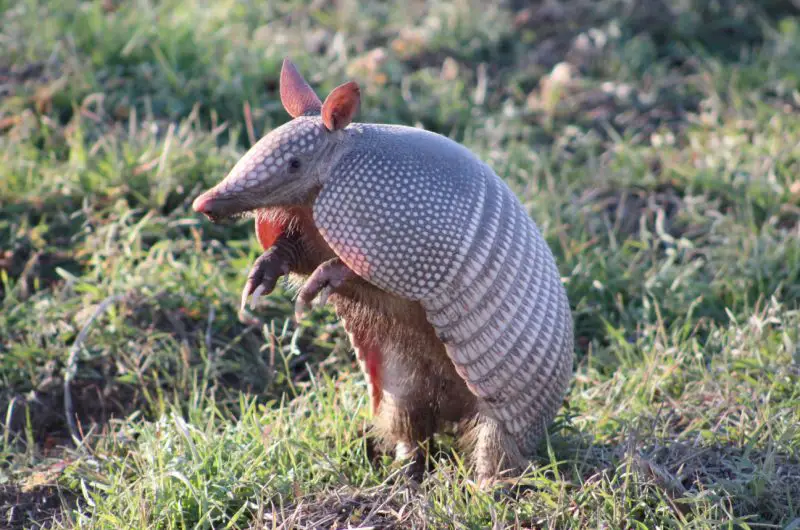Armadillos might look like creatures straight out of a prehistoric age, and in many ways, they are. Covered in bony armor and known for their quirky digging behavior, these small mammals are among Alabama’s most unexpected residents. Over the past few decades, armadillos have quietly spread across the state—showing up in backyards, gardens, and roadsides from Mobile to Huntsville.
But how much do you really know about these unusual animals? Many people in Alabama mistake armadillos for pests, while others are simply fascinated by their strange appearance and habits. In this detailed guide, we’ll uncover the hidden facts about armadillos in Alabama—their history, behavior, surprising adaptability, ecological role, and even how they might be beneficial to the environment.
By the end, you’ll see the nine-banded armadillo not as a nuisance, but as one of the most fascinating wild creatures sharing the Heart of Dixie.
Meet Alabama’s Armadillo

The Nine-Banded Armadillo (Dasypus novemcinctus)
The only armadillo species found in Alabama is the Nine-banded Armadillo, a small, burrowing mammal native to Central and South America. Over the past century, it has expanded northward across the southern United States, including Texas, Louisiana, Mississippi, and now Alabama.
The nine-banded armadillo gets its name from the bands of flexible armor running across its midsection. Despite what some might believe, not all armadillos can roll into a complete ball—only the three-banded armadillo of South America can do that. The nine-banded species instead relies on speed, digging, and camouflage for protection.
Physical Appearance
An average Alabama armadillo weighs between 8 and 17 pounds and measures about 2.5 feet long, including its tail. Its gray-brown armor is made of bony plates covered by tough skin. The long snout, pointed ears, and sharp claws make it perfectly equipped for digging up insects underground.
Armadillos have poor eyesight but a strong sense of smell. They can detect insects several inches below the surface and dig them out with surprising precision.
How Armadillos Reached Alabama
Expansion from the West
Armadillos originally lived in South America and Mexico, but as the climate warmed, they expanded northward into the United States. By the early 1900s, they had reached Texas, and by the mid-20th century, they were well established in Louisiana and Mississippi.
By the 1980s and 1990s, armadillos began to appear in southern Alabama, especially near Mobile Bay and Baldwin County. Today, they can be found throughout most of the state, even as far north as Huntsville.
Why Alabama?
Alabama’s mild winters, plentiful insects, and soft, loamy soils create ideal conditions for armadillos. The state’s combination of forests, fields, and suburban landscapes provides ample food sources and digging opportunities. The animals’ gradual expansion eastward was inevitable given the climate and food availability.
Climate Influence
Because armadillos are sensitive to cold, their northward spread slows wherever winters become harsh. However, Alabama’s relatively temperate climate allows them to thrive year-round, even during mild winters.
Surprising Behaviors of Armadillos
Nocturnal Lifestyle
In Alabama, armadillos are mostly nocturnal, coming out after sunset to forage. During cooler months, they may appear during the day to take advantage of the warmth. Their low body temperature and slow metabolism make them more active in mild or warm weather.
They typically spend most of the day sleeping inside burrows that can reach 7 feet deep and several feet long. These burrows help regulate temperature and provide protection from predators like coyotes and dogs.
Skilled Diggers
Armadillos are exceptional diggers. Their claws can move dirt faster than most small mammals, and they use them to create burrows and to dig up insects, grubs, and beetle larvae—their primary food sources.
If you’ve ever found small cone-shaped holes in your Alabama lawn, an armadillo was likely the culprit. Though their digging can frustrate homeowners, it actually aerates the soil and helps control insect populations.
The Famous Jump
When startled, nine-banded armadillos have a peculiar defensive behavior: they jump straight up into the air, sometimes as high as 3 to 4 feet. While this may help them avoid predators in the wild, it unfortunately contributes to their frequent road deaths—since jumping puts them right in the path of vehicles.
What Armadillos Eat in Alabama
Diet Overview
Armadillos are insectivores with a diet that includes beetles, ants, termites, earthworms, and grubs. They also occasionally eat small vertebrates, fruits, and roots.
Because Alabama’s environment provides a year-round supply of insects, armadillos never struggle to find food. Gardens, compost piles, and lawns full of soil invertebrates are irresistible to them.
The Hunting Technique
They use their sharp claws and strong forelimbs to dig shallow holes as they sniff out food. With a sticky tongue similar to that of an anteater, they can lap up insects quickly and efficiently.
This natural pest control makes them beneficial in some cases—they help reduce populations of destructive insects and grubs that can damage crops and turf.
The Reproductive Secrets of Armadillos
Identical Quadruplets
One of the strangest facts about Alabama’s armadillos is their unique reproductive system. Female nine-banded armadillos always give birth to identical quadruplets—four offspring cloned from a single fertilized egg. This means all siblings are the same sex and genetically identical.
Delayed Implantation
Another fascinating feature is delayed implantation. After mating, the fertilized egg can remain dormant for months before developing, allowing the female to time births for favorable conditions.
Birth and Development
Baby armadillos are born with soft, leathery shells that harden within a few weeks. They nurse for two to three months before leaving the burrow to forage with their mother. By six months, they are fully independent and capable of surviving on their own.
Armadillos and the Alabama Ecosystem
Nature’s Pest Controllers
Although often considered pests themselves, armadillos serve an important ecological role. Their digging helps aerate soil, distribute nutrients, and control insect populations.
In agricultural regions of southern Alabama, they indirectly reduce crop damage by consuming root-eating pests.
Prey for Predators
Armadillos are prey for coyotes, bobcats, and large birds of prey. Their armor provides protection but isn’t impenetrable—predators often flip them onto their backs to reach the unprotected belly.
Their presence in the food chain supports biodiversity and helps balance Alabama’s natural ecosystems.
Myths and Misconceptions About Armadillos
Myth 1: Armadillos Carry Leprosy to Humans
This is one of the most common fears in Alabama. While it’s true that armadillos can carry the bacteria Mycobacterium leprae (which causes leprosy), the actual risk of transmission to humans is extremely low. Direct contact with the animal’s blood or tissue would be required.
Simple precautions—such as wearing gloves if handling soil or remains—make infection virtually impossible.
Myth 2: Armadillos Destroy Foundations
Armadillo burrows can appear near driveways or under sheds, but they rarely cause structural damage. Their tunnels are shallow and generally collapse over time.
Myth 3: Armadillos Are Blind
While armadillos have poor eyesight, they are not blind. They rely heavily on smell and hearing to navigate and locate food.
Human and Armadillo Encounters in Alabama
Urban Adaptation
As Alabama’s suburbs expand, armadillos are learning to live closer to people. They are now a common sight in backyards, golf courses, and parks.
Homeowners often first notice them by the small holes left in lawns or gardens. Though they may appear as nuisances, their digging benefits the soil and reduces grub infestations naturally.
Road Mortality
Unfortunately, armadillos’ jumping behavior and slow reaction time make them frequent victims of vehicle collisions. Their population, however, remains stable due to their high reproductive success.
Living in Harmony
To deter armadillos from digging in yards, residents can use natural barriers, strong fences, or remove food attractants like compost and fallen fruit. Repellents with strong odors, such as castor oil-based sprays, can also discourage them from returning.
Climate Change and the Future of Armadillos in Alabama
Expanding Northward
As global temperatures rise, armadillos continue to expand northward beyond Alabama into Tennessee and the Carolinas. Alabama’s moderate winters will likely remain a comfortable habitat for them well into the future.
Ecosystem Resilience
While some fear their expansion could harm native species, studies show armadillos fill a unique ecological niche rather than replacing existing animals. Their ability to thrive in both wild and urban environments demonstrates remarkable adaptability.
Long-Term Coexistence
With education and management, humans and armadillos can coexist peacefully. Recognizing their role as natural pest controllers can turn potential conflict into appreciation for one of Alabama’s most misunderstood animals.
Fun and Lesser-Known Facts About Alabama Armadillos
- Armadillos can hold their breath for up to six minutes, allowing them to cross creeks and ponds by walking underwater.
- They are excellent swimmers—they inflate their intestines to stay buoyant.
- Armadillos’ shells are made of keratin, the same material as human fingernails.
- The name “armadillo” means “little armored one” in Spanish.
- Despite their armor, they have soft underbellies, which predators exploit.
- They dig multiple burrows within their territory and rotate between them to confuse predators.
- Armadillos have been in Alabama long enough that some rural folklore includes them as signs of good luck or weather change.
How to Protect and Appreciate Armadillos in Alabama
Observe, Don’t Disturb
If you see an armadillo in your yard, observe it from a distance. They are harmless to humans and pets unless cornered.
Avoid Using Harmful Chemicals
Because armadillos feed on soil invertebrates, excessive pesticide use can reduce their food supply. Choose eco-friendly lawn treatments to support a balanced ecosystem.
Educate Others
Armadillos are part of Alabama’s natural heritage. Sharing accurate information about them helps reduce unnecessary fear and harm.
Conclusion
Armadillos in Alabama are far more fascinating than most people realize. From their armor-clad bodies to their unique reproduction and night-time foraging habits, they represent an extraordinary success story of adaptation.
Once confined to Central America, these resilient creatures have conquered Alabama’s landscapes, from the Gulf Coast to the Appalachian foothills, without disrupting the natural balance. Their digging might be inconvenient, but it plays a small role in a much bigger ecological system.
So the next time you spot one of these “little armored” wanderers crossing your driveway or digging in your flower bed, take a moment to appreciate it. You’re looking at one of Alabama’s quietest but most remarkable wildlife residents—an animal whose secrets, once uncovered, are nothing short of surprising.






